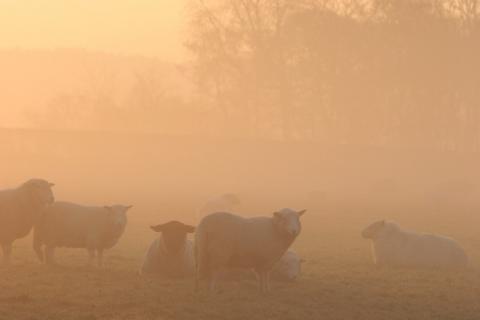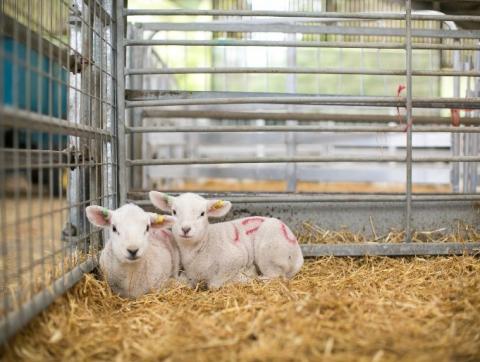19 February 2018
Take home messages:
- Addressing the correct nutritional requirements of the ewe during pregnancy is important for animal performance and welfare.
- During the last stage of pregnancy additional supplementation may be required dependent on body condition score (BCS).
- Analysis of feed can aid in determining the energy content of the ration for nutrient management, to minimise underfeeding or over feeding of ewes.
The nutrition of ewes within flocks is of paramount importance, not only during gestation but throughout the production cycle. Effects on early life development have repercussions later in life, so it is important to provide adequate health and nutrition for young lambs from the very start. Nutrition is a key factor for lamb production, even more so than the genetic potential of the animal. Therefore, the nutrition of the ewe during gestation is of huge importance. There are essentially three stages of pregnancy; the first, second and third trimesters, but more demands in terms of energy requirements do not appear until mid to late gestation when 70% of foetal growth occurs. In the last trimester, the increase in foetal growth means that any restrictions on nutritional requirements will have a detrimental effect on both ewe and lamb weight and welfare. During these last phases of gestation (final 4 weeks) 70% of udder development occurs, which also needs accounting for to provide colostrum for young lambs, a good milk yield and to maintain ewe performance. Studies have shown that either under or over feeding can have negative effects on ewes and lambs, therefore it is important to get the balance for nutritional requirements as accurate as possible.
Nutritional requirements
The nutritional requirements during pregnancy is dependent on the stage of gestation and the number of foetuses. Carbohydrates are the main source of energy, which are degraded in the rumen by rumen microorganisms and fermented into volatile fatty acids (VFA). VFAs (primarily acetate, propionate and butyrate) make up 50-70% of digestible energy. Forage feeds provide a main source of digestible carbohydrate, but concentrate diets consisting of starch and cereal grains also provide dietary energy. The type of diet will determine the population diversity of microorganisms present in the rumen, which in turn varies the levels of VFAs produced; for example, feeding silage will result in more propionate produced than acetate. Protein digestion is synergistic with energy and are the most considered nutrients in animal feeds. Protein is supplied as rumen degradable protein (RDP), protein degraded in the rumen that feed the rumen microorganisms or digestible ungraded protein (DUP), which passes through the rumen and is absorbed in the abomasum and small intestine alongside microbial protein, contributing to the protein requirements of the animal. The extent of degradation depends on the type of feed and the retention time within the rumen.
The content of nutrients within feed, such as silage, grass and concentrate, varies. Therefore accurate
levels of nutrients present in feed sources can be more accurately determined by feed sampling and analysis. Forages which are considered high in protein such as ryegrass during early growth stages provide good levels of nutrient requirements for animals in productivity compared to more mature forages, where supplementation may be required to provide adequate nutrition. In pasture based sheep production systems, pasture growth rates are generally low during the winter which overlaps with late pregnancy in sheep. In a study conducted in New Zealand, the impact of ewe body condition score (BCS) and nutrition during late pregnancy and their interaction on the performance of twin bearing ewes was determined. The results of the study showed that there was no advantage in terms of lamb weights when sheep were offered pasture masses of over 1,200 Kg/DM, however ewes offered 1,500 to 1,800 kg/DM pasture had better BCS and back fat depth. Therefore, a BCS above 2 in late pregnancy can aid in both ewe and lamb performance.
According to the National Research Council the nutritional requirement of a 70kg ewe carrying twin lambs at early gestation and late gestation is 1.69 Kg and 1.83 Kg daily DM intake respectfully; 13.5 Mj/d per day of ME (metabolisable energy) and 18.3 Mj/d respectfully and 97 g/d and 129 g/d metabolisable protein requirement respectfully. Studies have reported that suboptimal nutritional provision during the first three months of pregnancy has a subsequent effect on the ovulation rate of ewe lambs produced. Ovulation rate of ewes can be enhanced by improving nutrition during the 10 days before mating begins. However, it has been shown that overfeeding during the first few months of
pregnancy can reduce blood progesterone levels, which can be detrimental to embryo survival, therefore feeding maintenance levels of nutrition at this stage can be beneficial. However, altering the nutrition of the ewe during late gestation has been shown to influence both lamb and ewe performance. Nutrition during late gestation impacts not only on overall lamb weight and general health but also on the skeletal development of the foetus and the development of major functioning organs according to recent studies. Therefore, increasing protein intake within reason can improve performance. However, if overfeeding takes place negative effects may be incurred, for example energy intake may be directly excreted rather than utilised for the growing lamb. When considering post lambing, previous studies have focussed on nutrition during early pregnancy rather than mid to late pregnancy to influence lactation. Though, a study by Paten et al., (2013) aimed to identify the specific time where the mammary gland function can be programmed during foetal life. They found little effect on offspring milk production and body weights of future offspring; but, they did discover that both under and over feeding during early pregnancy could be detrimental to milk production. Thus, highlighting the importance for nutritional management during production.
Malnutrition can result in the loss of a lamb at ovulation, during gestation or at birth. During gestation the foetus is the main priority for nutrients, therefore high demands will be placed in the ewe to maintain the foetus. Ewes can lose 15kg body mass during pregnancy and produce normal lambs, however it depends on the reserve potential of the ewe. Many disease conditions seen in flocks also arise as a result of inadequate nutrition. These can include twin lamb disease, hypocalcaemia, hypothermia of lambs, joint ill, watery mouth, liver abscesses, pneumonia and lamb dysentery. Periparturient rise (PPR) is common in ewes from late pregnancy to early lactation where an increase in faecal egg count (FEC) occurs. This is thought to result from a decline in immunity within the ewe. As demands from metabolisable energy (ME) and metabolisable (MP) protein increase as foetal growth increases during the last stages of pregnancy, it is thought that by increasing the supply of MP, resistance to parasite infection will be increased. However, a study conducted by Sebastino et al., (2017) found that there were no effects of protein nutrition on FEC either pre or post-partum ewes, concluding that there is no advantage from increasing MP in the diet or DUP as a means to control PPR.
Best practice to ensure maximum productivity and profitability whilst minimising losses.
The main source of energy comes from forage feed, therefore analysis of forage provided is essential to determine the energy content of the ration. It is important to aim for a good quality forage to improve feed intake, which should reduce the need to include more concentrate feed in the diet, thereby reducing the level of cost. Short term nutritional flushing prior to mating may provide beneficial effects. It is suggested that increasing nutrient levels 10 days before the introduction of rams will ensure all the ewes have reached the required plane of nutrition when they are mated. Scanning ewes to determine the number of foetus’s present is also recommended to administer the correct nutritional requirements to each ewe to aid with nutritional management within flocks. It is also important to body condition score (BCS) ewes throughout the stages of gestation to determine those with need for supplementary feeding and to what level, dependent on the number of foetus’s present.
For a comprehensive review please read Feeding the Ewe (2016) by Povey, Stubbings and Phillips (AHDB Beef and Lamb).


